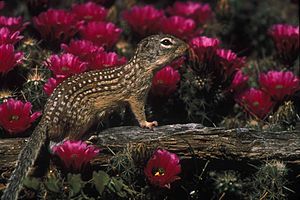Mexican ground squirrel facts for kids
Quick facts for kids Mexican ground squirrel |
|
|---|---|
 |
|
| Conservation status | |
| Scientific classification | |
| Genus: |
Ictidomys
|
| Species: |
mexicanus
|
| Synonyms | |
|
Spermophilus mexicanus |
|
The Mexican ground squirrel (Ictidomys mexicanus) is a type of rodent that belongs to the squirrel family, Sciuridae. You can find these small animals in Mexico and the United States. They are closely related to the thirteen-lined ground squirrel.
Contents
About the Mexican Ground Squirrel
The Mexican ground squirrel is a small to medium-sized rodent. It has a cool pattern of nine rows of white spots on its back. These squirrels are about 15 inches (38 cm) long. Male squirrels are usually a bit bigger than females. They also have small white circles of fur around their eyes and tiny ears.
Where They Live
Mexican ground squirrels live in northern Mexico, along the Texas Gulf Coast, and in parts of western and central Texas. You can also find them in southeastern New Mexico.
They like to live in flat areas that have bushes or grass. They especially prefer places with gravelly or sandy soil. Sometimes, they live in areas with lots of mesquite trees.
Even though humans have changed a lot of their natural homes, these squirrels have learned to live near people. Now, you might see them on golf courses or grassy areas next to highways.
Their Homes Underground
Each squirrel usually has more than one burrow, which is like an underground home. Each burrow can have up to five secret escape tunnels! You won't see a mound of dirt on top of their burrows, which helps keep them hidden. Most burrows have a special sleeping room for baby squirrels, which is lined with soft grasses.
What They Eat
The Mexican ground squirrel is an omnivore, meaning it eats both plants and animals. However, they mostly eat seeds and grains.
Their diet includes:
- Seeds
- Nuts
- Grains
- Roots
- Bulbs
- Plant stems and leaves
- Small mice
- Insects
- Eggs
They often store seeds, grains, and nuts in special pouches in their cheeks. They carry this food back to their den to eat later. In the summer, they enjoy eating insects. Sometimes, they have even been seen eating roadkill.
Life Cycle and Reproduction
The mating season for Mexican ground squirrels runs from April to mid-July. The busiest time for mating is in May. Female squirrels can have babies after their first time hibernating.
Hibernation
Most Mexican ground squirrels hibernate, which means they go into a deep sleep during colder months. However, some have been known not to hibernate at all!
Social Life
These squirrels are usually solitary, meaning they live alone. But during the mating season, they come together in groups. Female squirrels' hormone levels change during this time, which helps them get along in groups without fighting.
Raising Young
During the mating season, the female squirrel gets a nesting room ready in her burrow. She lines it with mesquite and grass to make it cozy. On average, a mother squirrel will have five babies at a time, but she can have anywhere from one to ten.
When they are born, the young squirrels have no teeth and no fur. They stay with their mother for about three months. After that, they leave to live on their own.
Staying Safe from Predators
The Mexican ground squirrel has a cool trick to help it survive snake attacks. It has developed a special resistance to the venom of the western diamondback rattlesnake! This means their body has something that stops the snake's venom from harming them too much.
Also, their small, rear-pointing ears are very good at hearing predators. This helps them detect danger and escape quickly.
See also
 In Spanish: Motocle para niños
In Spanish: Motocle para niños


